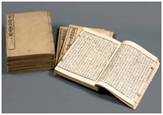Collection
Donguibogam: the Korean Traditional Medicine book

Dongeuibogam (동의보감; Principles and Practices of Eastern Medicine) is regarded as the classic book on Korean traditional medicine. It was compiled during the Joseon Dynasty by Jun Heo, who was the physician for the king and the royal family. Compilation of the book began in 1596, but was interrupted by the onset of the Japanese Invasions of Korea (also known as the Imjin War) that same year. The ensuing Jeong-yu invasion of 1597 nearly caused the book to be forever lost to humanity. However, thanks to Heo's endless efforts and support from King Seonjo and King Gwanghaegun, it was finally completed in 1610 and published in 1613. The publication of Dongeuibogam played a pivotal role in development of Korean eastern medicine.
Dongeuibogam was made up of 25 volumes, and its contents were divided into 5 sections: Naegyeong (internal organs); Oehyeong (external human body); Japbyeong (various diseases); Tangaek (herbal medicine); and Chimgu (acupuncture). Dongeuibogam differed from other medical books of the time in that the human body was the primary organizational theme of the book and that its central focus was on the prevention of and recuperation from disease. Before then, medical books from China and Japan were typically organized by disease, not by the human body. In Dongeuibogam, for example, the Naegyeong section
described the internal composition of the human body, such as the liver, heart, lungs, kidney, gallbladder, stomach, bladder, and large and small intestines. The Oehyeong section dealt with the exterior parts of the human body, such as the head, face, eyes, nose, mouth, skins, hands, and legs. It was Heo's creativity that conceived of Dongeuibogam's unique structure and organization, which were characteristics that made it the only book of its kind at the time.
There was high demand for Dongeuibogam from China and Japan, and they searched desperately for copies of Dongeuibogam. When envoys from China visited Korea, they invariably asked to obtain copies of Dongeuibogam. Because it was published in Japan first, Japanese doctors were able to make full use of Dongeuibogam before Chinese doctors were. But after China came to appreciate its value, it was published in China more than 30 times.
The praise and respect that Dongeuibogam earned was not just due to Heo's genius; it was also because in those days the Joseon Dynasty had the highest level of medical knowledge in all of East Asia. Even people today recognize the excellence of Dongeuibogam, which led to its being included in the UNESCO Memory of the World Register in July 2009. It is a great honor for Dongeuibogam to have been selected for this privilege.
 This website is the official e-government website of Korea.
This website is the official e-government website of Korea.
